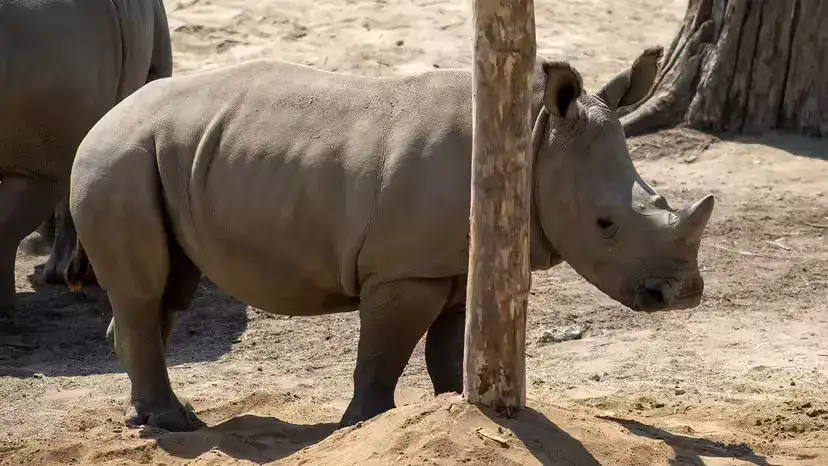Status: Critically Endangered (CR)
Wild population: Fewer than 100 individuals; all in Ujung Kulon National Park, Java, Indonesia
Primary risks: Low genetic diversity, food plants displaced by Arenga (langkap) palms, single-site population vulnerable to disasters/disease, no successful captive breeding
Latest note: As of October 2023, a newborn calf raised the park’s estimate to ~81 animals—still at extreme risk

The Javan rhino is one of Asia’s three rhino species (with the Indian and Sumatran rhinos). Adults measure 2–3.2 m long and weigh 0.9–2.3 tons, similar to a black rhino. Like the Indian rhino, Javan rhinos carry a single horn. Males also wield tusk-like elongated lower incisors used in combat.
Despite the imposing build, they are browsers/grazers, feeding on fallen fruit, shoots, and broad-leaf understory plants.
Horn count: Javan and Indian rhinos are single-horned; Sumatran and the two African species are two-horned.
Body & skin: Indian rhinos are larger with prominent “armor” folds; Javan rhinos have subtler folds and rougher skin.
Range: Javan rhinos now survive in one protected area only—a uniquely perilous situation.
Once widespread across South and Southeast Asia, the Javan rhino crashed in the 19th–20th centuries under poaching for horn and wholesale habitat loss.
Two subspecies are now extinct:
R. s. inermis (Bangladesh, Myanmar, NE India)
R. s. annamiticus (Cambodia, E Thailand, Laos, Vietnam)
Classified Critically Endangered since 1996.
Every wild Javan rhino lives in Ujung Kulon. A single tsunami, volcanic episode, epidemic, or invasive pathogen could wipe the species. Small effective population sizes also intensify inbreeding and genetic drift.
Arenga (langkap) palms race upward and close the canopy, suppressing the light-demanding shrubs, vines, and saplings that rhinos prefer. Since 2011, managers have selectively removed Arenga to recover palatable plants.
Javan rhinos are notoriously sensitive to captivity; the last captive individual died in 1907. Without an insurance population, everything depends on one wild site.
Biome: Coastal lowland monsoon forest—dense thickets, secondary forest mosaics, wet flats near streams and the shore.
Rhythm: Elusive, mostly solitary, active day and night; highly reliant on water and wallows for thermoregulation/parasite control.
Diet: Selective browser of broad-leaf shrubs, climbers, new shoots, and seasonal fruits; strong seasonality in plant choice.
Natural hazards: The park sits by coastline and volcanoes—tsunami, ash fall, storm surge could devastate core habitat.
Disease spillover: With no second population, a novel pathogen could sweep the species. Genetic uniformity can magnify virulence.
Management fragility: A spike in poaching, fire, invasive species, or a severe storm leaves no alternative population to offset losses.
Habitat Repair: Ongoing, targeted Arenga removal + enrichment planting to restore understory diversity/food plants.
Smart Patrol & Monitoring: Grid patrols, camera traps, and fecal DNA to track individuals, breeding, and range use; strict anti-poaching.
Community Co-management: Work with surrounding villages to reduce dependence on park resources and create alternative livelihoods.
Risk Diversification (under study): Technical assessments for a second secure site (adequate area, food, low disturbance, disease screening). Translocation remains contingent on rigorous readiness.
Disaster & Disease Preparedness: Early-warning and rapid-response protocols (quarantine, isolation, fire and storm plans, access control).
Red List: Critically Endangered (CR)
Wild count: <100 (≈ 81 in 2023/10)
Where: Only Ujung Kulon National Park, Java
Main threats: Low diversity, Arenga competition, single-site risk, no captive program
Priority actions: Food restoration – Arenga control – Strong protection – Risk planning – Evaluate second site
Why not start captive breeding now?
This species has failed in captivity historically and reacts poorly to confinement. Without validated husbandry, health, and behavioral protocols, attempting it could backfire. The safer, proven path is to thicken the wild habitat (more food, less disturbance) while lowering acute risks.
Does removing Arenga palms harm the forest?
Managers use targeted, phased, site-specific removal to increase heterogeneity and bring back the rhino’s food plants. It’s paired with native forage plant restoration—a net ecological gain when done carefully.
Why not translocate some rhinos now?
Translocation needs a ready, secure habitat (area, food, cover, water), disease-risk clearance, individual health/behavior vetting, and decades of funding and governance. Until those boxes are checked, rushing a move raises risk.
Support organizations doing anti-poaching, habitat restoration, and long-term monitoring.
Share evidence-based updates and avoid sensational or misleading conservation content.
When visiting the region, follow park rules, respect closures, and never buy wildlife products.
animal tags: javan rhino
We created this article in conjunction with AI technology, then made sure it was fact-checked and edited by a Animals Top editor.